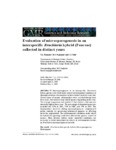Por favor, use este identificador para citar o enlazar este ítem:
http://www.alice.cnptia.embrapa.br/alice/handle/doc/326850Registro completo de metadatos
| Campo DC | Valor | Lengua/Idioma |
|---|---|---|
| dc.contributor.author | FUZINATO, V. A. | pt_BR |
| dc.contributor.author | PAGLIARINI, M. S. | pt_BR |
| dc.contributor.author | VALLE, C. B. do | pt_BR |
| dc.date.accessioned | 2011-10-01T01:00:07Z | - |
| dc.date.available | 2011-10-01T01:00:07Z | - |
| dc.date.created | 2009-04-20 | pt_BR |
| dc.date.issued | 2008 | pt_BR |
| dc.identifier.citation | Genetics and Molecular Research, Ribeirão Preto, v.7, n. 2, p. 424-432, 2008. | pt_BR |
| dc.identifier.uri | http://www.alice.cnptia.embrapa.br/alice/handle/doc/326850 | pt_BR |
| dc.description | Microsporogenesis in an interspecific Brachiaria hybrid, grown in the field under natural environmental conditions in Brazilian savannas, was analyzed in three distinct years of collection. Several types of meiotic abnormalities were recorded during those three years, but varied in type and frequency depending on the year. The average temperature and rainfall 15 days before collection was unusually high in those years. The percentage of abnormal meiocytes recorded was 62% in 2001, 73% in 2004, and 77% in 2005. The abnormalities observed during microsporogenesis compromised pollen viability by generating unbalanced gametes or affecting nucleolus organization. The environmental conditions under which the hybrid was growing could have affected the genetic control of meiosis. More detailed studies, under controlled conditions, are necessary to better understand the effects of environmental factors on Brachiaria microsporogenesis hybrids. | pt_BR |
| dc.language.iso | eng | eng |
| dc.rights | openAccess | eng |
| dc.subject | Microsporogênse | pt_BR |
| dc.subject | Braquiária | pt_BR |
| dc.subject | Campo Grande | pt_BR |
| dc.subject | Mato Grosso do Sul | pt_BR |
| dc.subject | Brasil | pt_BR |
| dc.title | Evaluation of microsporogenesis in an interspecific Brachiaria hybrid (Poaceae) collected in distinct years. | pt_BR |
| dc.type | Artigo de periódico | pt_BR |
| dc.date.updated | 2018-01-29T11:11:11Z | pt_BR |
| dc.subject.thesagro | Melhoramento genético vegetal | pt_BR |
| dc.subject.thesagro | Pastagem | pt_BR |
| dc.subject.thesagro | Citogenética vegetal | pt_BR |
| dc.subject.thesagro | Meio ambiente | pt_BR |
| dc.subject.thesagro | Hibrido | pt_BR |
| dc.subject.thesagro | Planta Forrageira | pt_BR |
| riaa.ainfo.id | 326850 | pt_BR |
| riaa.ainfo.lastupdate | 2018-01-29 -02:00:00 | pt_BR |
| dc.contributor.institution | Veridiana Aparecida Fuzinatto, UEM; Maria Suely Pagliarini, UEM; CACILDA BORGES DO VALLE, CNPGC. | pt_BR |
| Aparece en las colecciones: | Artigo em periódico indexado (CNPGC)  | |
Ficheros en este ítem:
| Fichero | Descripción | Tamaño | Formato | |
|---|---|---|---|---|
| gmr430.pdf | 1 MB | Adobe PDF |  Visualizar/Abrir |









